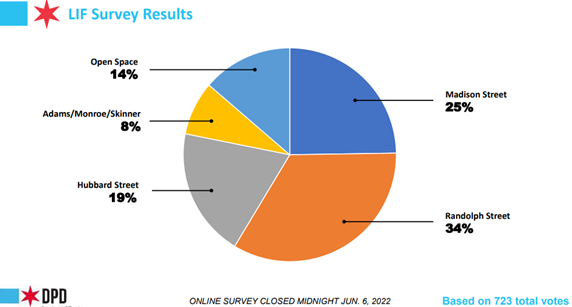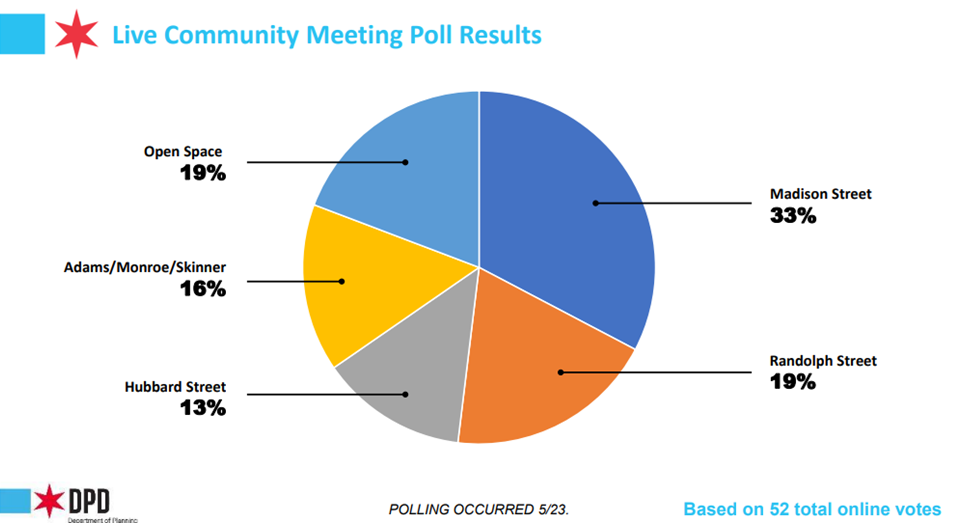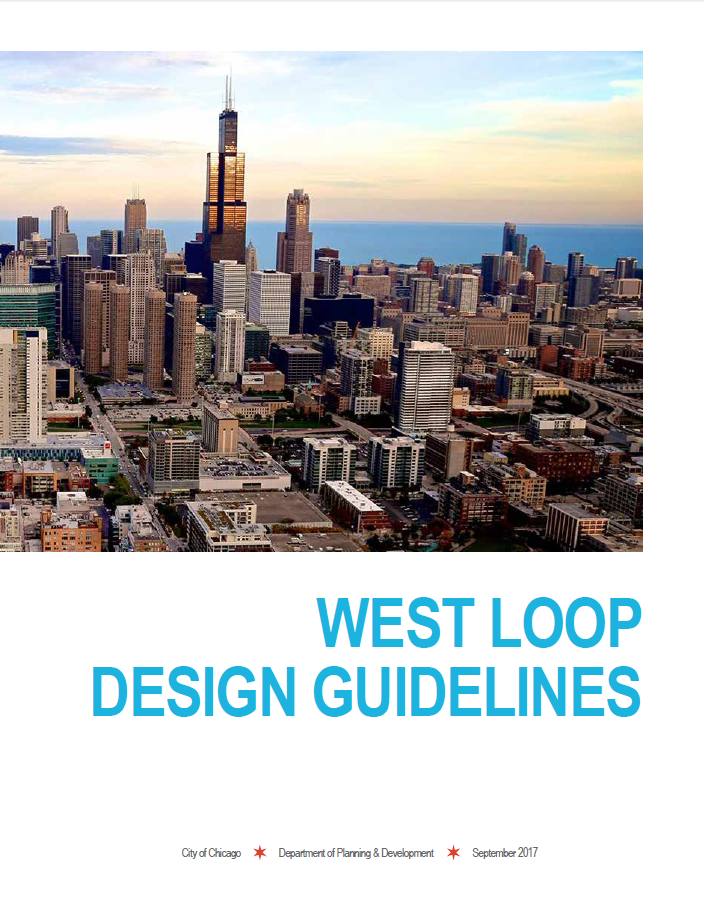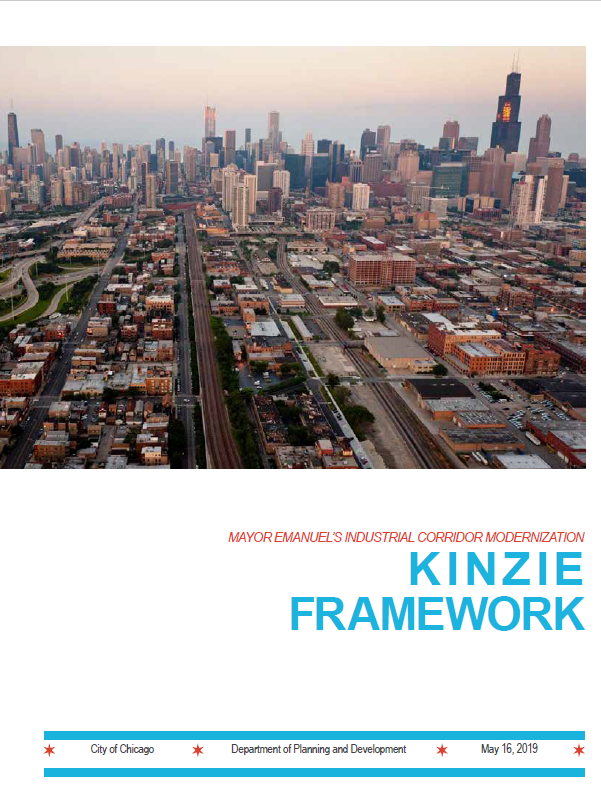West Loop Resource Guide
Updated Oct. 3, 2022
To help guide West Loop investment and growth, the Department of Planning and Development (DPD) is making the maps, plans, initiative information, and other resources available below to the public. These documents are among the materials that DPD and other City agencies use to assess proposed development projects that require formal review.
West Loop residents, stakeholders and developers can sign up for email updates from DPD to ensure they receive the latest planning news in the West Loop.
Local Impact Funds
The Local Impact Fund (LIF) receives 10% of the revenues generated by the Neighborhood Opportunity Bonus program, which enables developers of downtown construction projects to increase floor area in exchange for voluntary payments. The Adopt-A-Landmark Fund also receives 10% and the Neighborhood Opportunity Bonus fund receives 80%. LIF funding is allocated by DPD in consultation with local aldermen towards eligible public improvements in the downtown area.
On May 23, 2022, DPD and the Chicago Department of Transportation (CDOT) hosted a virtual community meeting with Ald. Walter Burnett (27th), Ald. Byron Sigcho-Lopez (25th) and Ald. Jason Ervin (28th) to solict feedback on local priorities for LIF funding in the West Loop. The engagement process included a live survey with 52 responses and an online survey with 723 responses. A recording of the meeting and the survey results are below.
As a result of public feedback, timing and funding considerations, $2.9 million in LIF is being allocated toward Madison Street improvements between Ogden Avenue and Halsted Street. CDOT will use the funding in early 2023 to refine the project scope, budget and overall construction timeline.
For the other projects that were included in the survey but not selected in this round of LIF allocations, DPD will continue to work with area aldermen, departments, and sister agencies towards their implementation.


Proposed Metra Station and Track Realignment
On Oct. 12, 2021, CDOT and DPD co-hosted an informational webinar with Ald. Walter Burnett (27th) to update the Near West Side community on the feasibility of a future Metra station and a related track realignment project. The meeting presentation is available for review.
New Affordability Goals in the FMID
The City of Chicago is seeking to create more mixed-income development in the West Loop by providing more affordable housing options in the Fulton Market Innovation District (FMID), as recommended in the FMID Plan Update adopted by the Chicago Plan Commission in February 2021.
The plan update calls for new development to try and exceed the City's typical affordable housing requirements, which range from 10 to 20 percent affordable units for new residential developments. For the area north of Lake Street, within the FMID, the City will work with developers to achieve 30 percent affordability. Given current market conditions, the City expects the higher percentage will require public assistance. More information on this and other recent reforms to the Affordable Requirements Ordinance (ARO) can be found on the Department of Housing's website.
Kinzie Industrial Corridor Infrastructure Study
DPD commissioned a study in 2019 to analyze the infrastructure conditions within the Kinzie Industrial Corridor from Lake Street to Hubbard Street and from Halsted Street to Odgen Avenue. Prepared by AECOM and completed in 2020, the goal of the study is to identify existing condition infrastructure issues, opportunity sites that may be developed in the future, and infrastructure priorities for the area.
West Loop Design GuidelinesIn 2017, DPD published design guidelines to foster excellence in design within the West Loop. As the West Loop has evolved, the City of Chicago has undertaken planning efforts to encourage the thoughtful redevelopment of this area. After an extensive public review period, the Chicago Plan Commission (CPC) adopted the West Loop Design Guidelines in September 2017. The guidelines ensure that development in the West Loop continues to:
The public process included more than 300 participants across two public open houses, three working group meetings and an online survey.
|
Kinzie FrameworkThe Kinzie Industrial Corridor Framework Plan was approved by CPC in May 2019. The plan was a result of a community-based process led by the Department of Planning and Development to review and enhance the Kinzie Industrial Corridor. As part of the Industrial Corridor Modernization Initiative, the process intends to maintain the corridor as an economic engine and vital job center, provide better access for all transportation modes, and enhance the area’s unique built environment. The framework identifies corridor employment trends and land use changes over time, as well as the historic character and development of the area, and makes recommendations to encourage industrial and some commercial development for continued employment growth within the corridor. The public process included more than 200 participants across two community meetings. |
Zoning Change East of Ogden
The Kinzie Corridor overlay district regulations, adopted in May 2017, supplement the zoning regulations that apply under a property's base zoning district. The general purpose and intent of the overlay district is to help:
- Facilitate and guide land use transitions from the area’s former Planned Manufacturing District (PMD) zoning designation in some areas
- Accommodate and promote compatible mixes of office, industrial and commercial uses
The change in zoning was adopted by City Council as a part of the implementation process for the 2014 Fulton Market Innovation District, referenced below.

Downtown Zoning Expansion and Neighborhood Opportunity Bonus
Updates to the Chicago zoning code's downtown floor area ratio (FAR) bonus system and downtown zoning district geography were approved by City Council in May 2016. The Neighborhood Opportunity Bonus system seeks to:
- Simplify and update the downtown floor area bonus system
- Accommodate ongoing central area growth through an expanded downtown zoning district
- Provide new funding sources to encourage commercial development in neighborhoods lacking private investment.

Fulton-Randolph Market Landmark District
After more than a year of public review, City Council designated the Fulton-Randolph Market District as a Chicago Landmark in July 2015. This designation enhances the area's prestige, increases the value of the properties within it, and will continue to stabilize an entire neighborhood by encouraging developers to:
- Recognize and preserve the historic significance and importance of the district's historic streetscapes and buildings
- Qualify buildings for historic rehabilitation incentives under various federal, state and local economic incentive programs
The public review processes included seven public meetings or open house events.

Fulton Market Innovation District (FMID)
The FMID Plan was adopted by CPC in July 2014 and identifies a vision to preserve existing jobs while accommodating private sector investments that reinforce the area's expanding role as an innovation-driven employment center. The FMID is the original, guiding document that led to the creation of all the aforementioned ordinances.
The public process included more than 450 participants across three public meetings and seven smaller neighborhood meetings.
Kinzie Industrial Corridor Infrastructure Study
DPD commissioned a study in 2019 to analyze the infrastructure conditions within the Kinzie Industrial Corridor from Lake Street to Hubbard Street and from Halsted Street to Odgen Avenue. Prepared by AECOM and completed in 2020, the goal of the study is to identify existing condition infrastructure issues, opportunity sites that may be developed in the future, and infrastructure priorities for the area.
Enterprise Zones
The City of Chicago has six Enterprise Zones, and the West Loop falls within Enterprise Zone 4. The primary purpose of the Enterprise Zone program is to stimulate economic growth and neighborhood revitalization by offering state and local tax incentives to companies expanding or relocating within depressed areas.
Supporting Information Facts
Department:
People We Serve:
Additional Information
Get West Loop email updates from DPD
Randolph Street Corridor Improvement Study (CDOT)
Fulton Market Streetscape Project (CDOT)
Fulton Market Traffic Study Community Meeting (September 2023)
DPD update on Fulton Market planning efforts (September 2020)
DPD memo on developments next to at-grade Metra crossings (August 2023)




